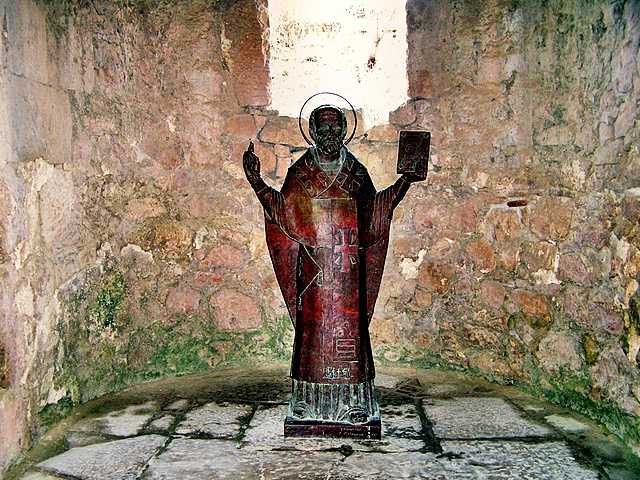St. Nicholas preached and died in Demre, where his legend lives on
Matt Porter
GlobalPost
DEMRE, Turkey — When journalist Francis Church replied to 8-year-old Virginia O’Hanlon in 1897, “Yes, Virginia, there is a Santa Claus,” he could have added: “in Turkey.”

Hundreds of Orthodox Christians and other pilgrims descended on the village of Demre, Turkey, to the St. Nicholas Church where St. Nicholas served as the Bishop of Myra from 325-350 A.D.
The church still stands today, but has been destroyed and rebuilt several times. St. Nicholas was martyred here and buried under the church until his bones were stolen by Italians in 1087 and taken to Bari, Italy, where they remain.
“We’re lucky to still have this church intact,” said priest Vissarion Komezias, who was one of the celebrants at the 2009 celebration of St. Nicholas’ feast day, which is marked by Christians around the world on Dec. 6.
“At best, they become museums [like this], at worst they are abandoned or destroyed,” said Komezias.
For the last three years, the Turkish government has allowed the Eastern Orthodox Church to once again celebrate a mass in Nicholas’ church. From 2002 to 2006, the Turkish government had organized its own “prayer for peace” instead.
During the 2009 liturgy given in both Greek and Turkish, celebrant Hrisostomos Kalaycı from the Istanbul Patriarchate thanked the Ministry of Culture and Tourism.
“The people of Anatolia have been famous since ancient times for their diligence, their faith in God’s orders, their honesty and modesty,” Kalayci said. “I pray to God for love and peace in our country. May St. Nicholas help us all.”
Kalayci, Komezias, and other priests from the Orthodox Church served the wall-to-wall crowd. Candles flickered against the crumbling walls of the more than 1,500-year-old church while pictures of John the Baptist, Jesus, Mary and child, and Saint Nicholas himself adorned the altar. The saint’s image was brought to the center where a candle and the bishop’s mitre (traditional headdress) rested beside it.
The crumbling pillars next to the altar symbolized the church’s tumultuous history that includes earthquakes and war. The church underwent several restorations including by the Romans in 1043, the Russians in the 19th century, and more recently with the assistance of the small Greek island of Megisti.
“Our people rebuilt this church,” said Megisti resident Evangelia Mavrothalassitis.
Turkish officials gave the 73-year-old Mavrothalassitis and her son free admission to the church for the labor her island contributed during the last restoration. Megisti, or Kastellorizo, sits just a few miles off the coast of Demre. In 2006, the Turkish Ministry of Culture made a $40,000 investment to restore the church’s roof.
Saint Nicholas, known commonly for his generosity to children, is actually patron saint to the most causes and people — among them: sailors, bakers, thieves, Greece, Apulia and Sicily. Nicholas was first named a patron to sailors after a legend emerged that he appeared to seamen caught in a tempest and guided them home.
“We grew up in Germany knowing the legend of St. Nicholas,” said 58-year-old Erica Venna. “We wanted to see the origins for ourselves.”
Germans, Greeks, Russians and Italians were among the countries represented at the service. A group of German university students came with their Turkish-born professor as their guide.
“Our aim [today] is to present Santa Claus as a real man who helped poor people,” said Ismet Yenmez. “We also want to introduce Turkish culture to the students.”
One story tells of a man in Myra who had no dowry to offer any of his three daughters. Without a dowry, historians say “women were sold into slavery or worse.” According to the legend, St. Nicholas threw three bags of gold through the man’s window on three different nights. Some say the bags landed in a stocking or shoe, which is where the European tradition originated. Three separate historical accounts tell this story differing only on the number of women or amount of gold, according to the Saint Nicholas Center.
Thirty-two countries from around the world have distinct traditions devoted to Nicholas, including Muslim Turkey.
“All of us love Noel Baba [Father Noel],” said 44-year-old Demre resident Nurhan Kale. “He is from here. He has his own culture here.”
When asked why Turks love St. Nicholas, Kale said that St. Nicholas was “good to children.” In Turkey, some parents give their children presents on New Year’s Day in honor of the mythical gift-giving Noel Baba. The holiday is celebrated without any religious references.
“We tell the children he was an important man and this is why you are receiving the gift,” Kale added.
Whether you know him as Saint Nicholas, Santa Claus, Noel Baba, Father Christmas, Papa Noel, Kris Kringle or Belsnickle, the legend will always have its origins along Turkey’s Mediterranean seaside.

Leave a Reply